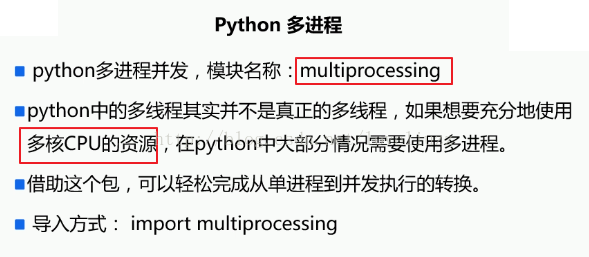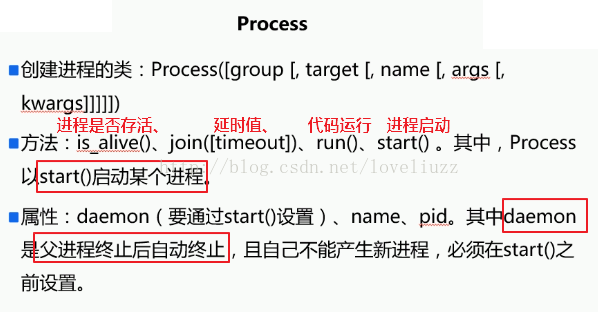Python3.5多进程原理与用法实例分析
本文实例讲述了Python3.5多进程原理与用法。分享给大家供大家参考,具体如下:

进程类:Process

示例及代码:

(1)创建函数作为单进程
#!/usr/bin/env python
# -*- coding:utf-8 -*-
# Author:ZhengzhengLiu
import multiprocessing
import time
#创建函数并将其作为单个进程
def worker(interval):
n = 5 #进程数
while n>0:
print("The time is :{0}".format(time.ctime())) #初始化时间
time.sleep(interval) #睡眠时间
n-=1
if __name__ == "__main__":
# 创建进程,target:调用对象,args:传参数到对象
p = multiprocessing.Process(target=worker,args=(2,))
p.start() #开启进程
print("进程号:",p.pid)
print("进程别名:",p.name)
print("进程存活状态:",p.is_alive())
运行结果:
进程号: 6784
进程别名: Process-1
进程存活状态: True
The time is :Wed Nov 1 10:59:03 2017
The time is :Wed Nov 1 10:59:05 2017
The time is :Wed Nov 1 10:59:07 2017
The time is :Wed Nov 1 10:59:09 2017
The time is :Wed Nov 1 10:59:11 2017
(2)创建函数作为多进程
#!/usr/bin/env python
# -*- coding:utf-8 -*-
# Author:ZhengzhengLiu
import multiprocessing
import time
#创建函数作为多进程
def work1(interval):
print("work1...")
time.sleep(interval)
print("end work1...")
def work2(interval):
print("work2...")
time.sleep(interval)
print("end work2...")
def work3(interval):
print("work3...")
time.sleep(interval)
print("end work3...")
if __name__ == "__main__":
p1 = multiprocessing.Process(target=work1,args=(1,))
p2 = multiprocessing.Process(target=work2,args=(2,))
p3 = multiprocessing.Process(target=work3,args=(3,))
p1.start()
p2.start()
p3.start()
print("The number of CPU is %d:"%(multiprocessing.cpu_count())) #打印CPU核数
for p in multiprocessing.active_children(): #循环打印子进程的名称和pid
print("子进程名称:%s,子进程pid:%d" %(p.name,p.pid))
print("ending....")
运行结果:
The number of CPU is 4:
子进程名称:Process-2,子进程pid:7108
子进程名称:Process-1,子进程pid:1896
子进程名称:Process-3,子进程pid:7952
ending....
work3...
work1...
work2...
end work1...
end work2...
end work3...
注:先运行主进程的内容,再运行子进程
(3)将进程定义成一个类
#!/usr/bin/env python
# -*- coding:utf-8 -*-
# Author:ZhengzhengLiu
import multiprocessing
import time
#将进程定义为一个类
class ClockProcess(multiprocessing.Process):
def __init__(self,interval):
multiprocessing.Process.__init__(self) #重构了Process类里面的构造函数
self.interval = interval
def run(self): #固定用run方法,启动进程自动调用run方法
n = 5
while n>0:
print("The time is {0}".format(time.ctime()))
time.sleep(self.interval)
n-=1
if __name__ == "__main__":
p = ClockProcess(2)
p.start()
运行结果:
The time is Wed Nov 1 11:31:28 2017
The time is Wed Nov 1 11:31:30 2017
The time is Wed Nov 1 11:31:32 2017
The time is Wed Nov 1 11:31:34 2017
The time is Wed Nov 1 11:31:36 2017
(4)Queue(队列)实现多进程数据传输
#!/usr/bin/env python
# -*- coding:utf-8 -*-
# Author:ZhengzhengLiu
import multiprocessing
#Queue是多进程安全的队列,可以使用实现多进程之间的数据传递
def writer_proc(q):
try:
q.put(1,block=False) #put方法插入数据到队列中
except:
pass
def reader_proc(q):
try:
print(q.get(block=False)) #get方法从队列中读取并删除一个元素
except:
pass
if __name__ == "__main__":
q = multiprocessing.Queue()
writer = multiprocessing.Process(target=writer_proc,args=(q,))
writer.start()
reader = multiprocessing.Process(target=reader_proc,args=(q,))
reader.start()
reader.join()
writer.join()
运行结果:
1
更多关于Python相关内容感兴趣的读者可查看本站专题:《Python进程与线程操作技巧总结》、《Python数据结构与算法教程》、《Python函数使用技巧总结》、《Python字符串操作技巧汇总》、《Python入门与进阶经典教程》、《Python+MySQL数据库程序设计入门教程》及《Python常见数据库操作技巧汇总》
希望本文所述对大家Python程序设计有所帮助。